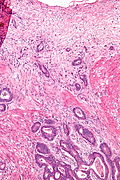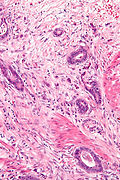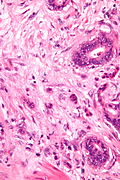Difference between revisions of "Tumour budding"
Jump to navigation
Jump to search
m (→Microscopic) |
|||
| Line 23: | Line 23: | ||
==See also== | ==See also== | ||
*[[Gastrointestinal_tract_polyps#High-risk_features_in_.28colorectal.29_adenomatous_polyps_with_carcinoma|High risk features in colorectal adenomatous polyps]]. | *[[Gastrointestinal_tract_polyps#High-risk_features_in_.28colorectal.29_adenomatous_polyps_with_carcinoma|High risk features in colorectal adenomatous polyps]]. | ||
*[[In-transit metastasis]]. | |||
*[[Tumour deposits]]. | |||
==References== | ==References== | ||
Revision as of 15:19, 11 October 2015
Tumour budding refers to lone tumour cells or small clusters of tumour cells at the advancing front of a tumour.[1]
Microscopic
Definitions:
- Tumour bud = 1-4 cell(s) -- at the tumour front.
- "High-grade budding" is >=10 tumour buds in a field of 0.385 mm2.[1]
Note:
- If the microscope has a 22 mm eye piece and...
- A 20x objective, the field is approximately 0.950 mm2 -- to match the buds/area -- it would be 24.68 buds/0.950 mm2.
- A 40x objective, the field is approximately 0.238 mm2 -- to match the buds/area -- it would be 6.17 buds/0.238 mm2.
DDx:
- Poorly differentiated adenocarcinoma.
Images
Tumour budding in CRC - intermed. mag. (WC)


